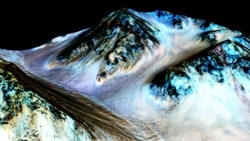Chinese researchers say they have built an artificial intelligence (AI) robot that can carry out chemical reactions to produce oxygen from water on Mars.
The system could be another way for space travelers in the future to make much-needed oxygen on Mars. Humans visiting the Red Planet will need oxygen to support life. The gas could also be used to make rocket fuel, which is difficult to transport to space.
Scientists have already established from multiple studies that Mars contains large amounts of water. Most of the water exists in the form of ice. Developers of the new robot system in China say it can be used to release oxygen from the planet’s water supply.
Scientists at the University of Science and Technology of China in Hefei led the research. The team explored whether an AI robot could use materials found on Mars to produce catalysts to break down water and release oxygen. A catalyst is a substance that permits certain chemical reactions to happen.
Experiments were carried out on meteorites that either came from Mars or contained materials similar to the Martian surface. The researchers said the “robot chemist” first used an acid and chemical mixture to separate and examine materials contained in the meteorites. It identified several different metallic elements, including iron, nickel, magnesium and aluminum.
The machine then worked to identify different molecules that could be produced from meteorite materials. The team said the system found more than 3.7 million possible molecule combinations.
The robot used that data to predict which catalysts would be able to split water molecules to produce oxygen. The catalyst chosen as the best fit was able to operate at minus 37 degrees Celsius. This temperature is similar to current conditions on Mars.
A press release announcing the experimental findings said the AI chemist was able to complete the whole process without human involvement in just two months. The release claimed such an operation “would take 2000 years for a human chemist” to finish.
The publication Nature Synthesis reported the full results of the study.
The study’s lead writer, Jun Jiang, told the website Space.com that as a boy, he often dreamed of being able to one day travel in space. "So when we finally saw that the catalysts made by the robot could actually produce oxygen by splitting water molecules, I felt like my dream was coming true. I even started to imagine that I, myself, will live on Mars in the future."
The researchers said they plan next to test whether their AI system performs well under a series of other conditions – besides temperature – found on Mars.
A report explaining the study’s results in Nature notes Jiang suggests that for every square meter of Martian material, his group’s system could produce nearly 60 grams of oxygen per hour. The researchers say this level of production could remove the need for future astronauts to transport oxygen from Earth. “The robot can work continuously for years,” Jiang said.
Jiang told Nature he thinks his team’s robotic system could also be used to produce other useful catalysts on Mars. This could include processes for making substances to support the growth of plants that could be used to produce food for astronauts.
“Different chemicals can be made by this robot,” Jiang said. He noted that Mars might also not be the only place where it could find other uses, suggesting the moon as another possibility.
I’m Bryan Lynn.
Bryan Lynn wrote this story for VOA Learning English, based on reports from the University of Science and Technology of China and Nature.
_______________________________________
Words in This Story
meteorite – n. a piece of rock from outer space that has fallen to a planet’s surface











Forum